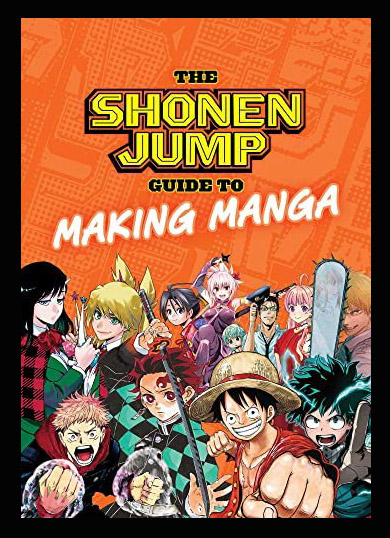
As a quick glance at any bookstore or Amazon will confirm, the popularity of manga in the US has produced a flood of how-to books aimed at adolescent/teen-age artists. In addition to the general books, there are specialized volumes focusing on everything from accessories to hair styles to furry characters and mecha. An unscientific sampling suggests that nearly all of them focus on standard poses and formulae.
The editors of Shonen Jump offer a more sensible guide that presses readers to discover what they truly want to draw, then develop the skills to present it. No one is in a better position to know: Weekly Shonen Jump has a circulation of more than 1.5 million and has sold a staggering 7.5 billion copies since the magazine began publication in 1968. “Dragon Ball,” “Slam Dunk,” “Hunter x Hunter,” “My Hero Academia” and the record-breaking “One Piece” are among the hit titles serialized in Shonen Jump.

In the first chapters, the authors explain they originally intended to produce a “how to draw easy-to-read manga” book. But when they consulted several of their artists, the feedback they received was “Emphasizing technical know-how is a surefire way to bog down readers with a bunch of preconceived notions, which could paralyze them when it comes time to sit down and draw.” Instead, “Making Manga” suggests ways to channel the reader’s passion constructively.
The writers tie the book together with the story of Kosei, a 15-year-old aspiring manga-ka who receives thoughtful guidance from Saito and Asada, two avuncular editors at Shonen Jump. In their first meeting, Saito explains, “There’s no resource that can teach you the ‘correct’ way to make manga. In fact, you’re misleading yourself if you that a singular correct method exists at all.”
Saito urges Kosei to forget about templates, think deeply and discover the stories he wants to tell and the characters who can bring them to life. In addition to reading manga, he should copy individual pages, as an art student copies paintings in a museum. Observe and sketch people, animals and landscapes; build up a reference library of photos. Read books and watch movies to learn from their story telling. Draw constantly. Focus on completing short stories rather than beginning a lengthy saga, only to abandon it before it’s finished.

The writers back up Kosei’s lessons with interviews from some of the world’s most successful manga artists: Gege Akutami (“Jujutsu Kaisen”), Tite Kubo (“Bleach”), Koyoharu Gotouge (“Demon Slayer: Kimetsu no Yaiba”), Kohei Horikoshi (“My Hero Academia”) and Eiichiro Oda (“One Piece”). In one extremely effective chapter, four of the artists sketch out the same two-page stories and explain their visual and narrative choices.
Additional chapters are devoted to practical details, from explanations of how to lay out pages for a printer to discussions of the relative merits of various inks, pens and papers—and software and hardware for artists who prefer to use digital technology. Although he wrestles with a lot believable anxieties and doubts, Kosei gradually improves—as will any talented kid who follows the editors advice.
“Making Manga” is an outstanding holiday gift choice for an aspiring artist–one that will win the donor the title of “coolest relative.”
The Shonen Jump Guide to Making Manga
By The Weekly Shonen Jump Editorial Department, translated by Caleb Cook
Viz: $16.99, paperback, 180 pp.
- Charles Solomon’s Animation Year End Review 2023 - December 28, 2023
- INTERVIEW: Makoto Shinkai on “Suzume” - November 27, 2023
- Interesting Portrayals of Gay Men in Manga/Anime - June 12, 2023


 October 29th, 2022
October 29th, 2022  Charles Solomon
Charles Solomon  Posted in
Posted in  Tags:
Tags: 






